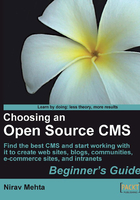
Time for action-setting your expectations for "The Yoga Site"
- Pick up a pen and a blank paper. Put a title at the top—The Yoga Site.
- On the extreme left, write down Intended Outcomes.

- Below this, write down top three results we want from our site. In this case, we want to provide yoga-related information to visitors, make money by selling yoga products from our partners, and create a community of yoga followers. Write these points in a bullet form and keep three blank lines between each point.

- Now is a good time to look at each outcome individually and think through what exactly we want. Look at those three lines we left after each outcome. Write What in the first line, Why in the second, and How in the third.

- Think about answers to these three questions: What do we want to do in selling yoga products? Why do we want to sell them? How will we sell them? Repeat these questions for all outcomes. Once you are through, write down some key words from your answers next to what, why, and how.
- Read through the list now and revise it as you see fit.
- The final Intended Outcomes list may look like this.

What just happened?
We just set clear outcomes for the Yoga site.
First, we wrote down the top three results we want from our site. We limited ourselves to only three results because we wanted to be clear about our most important targets.
Then we brainstormed the What part, which helped us clarify the kind of information we want to provide. We used key words to keep our list short yet meaningful. We did similar brainstorming to answer the Why and How questions. Answering the Why question allows us to understand the real purpose of our site. The answers to the Why questions should be real focus of our efforts.
We forced ourselves to think about our implementation strategy to achieve the desired outcome via How questions. This is important because the key words in the How section represent real content that should be available on our site.
This list will now serve as a guide. Whenever we are in doubt about adding some content or feature, we can consult this list to determine whether we should do it or not. Of course, we can update this list as and when we want. Focusing on the most important targets help us achieve them.
Here's a wrap up on the process.
Creating intended outcomes
- Limit yourself to the top three results.
- Think about the needs of your target audience.
- Ask:
- What—What will it do? What will be there? What will not be there? What will the site stand for? and so on.
- Why—Why will it do that? Why do you want it? Why will people come to the site? and so on.
- How— will it be done? How will the goals be accomplished? and so on.
- Show your list to someone who's interested in the subject. Get feedback.
- Review and revise the list as needed.
Pop quiz
- What CMS should we use for Oprah's site?
- Joomla is good and will satisfy the goals we listed.
- We need to evaluate our requirements further, before selecting a solution.
- A blog—Wordpress—is best for Oprah. It will even allow her to post yoga lessons.
- We will have to build one from scratch.
2. Why are What questions important?
- Human minds can think of ends better than means. So, it is easier to start with What.
- Well, Why and How are more important than What.
- They clarify the requirements of a site. We are forced to think exactly what we want.
- They are the first questions that come to one's mind.
3. What is the foremost reason for CMS project failures?
- Weak management support
- Unrealistic schedules
- Integration with existing systems
- Getting into technical details before defining requirements
Have a go hero-different goals for different sites
We looked at a yoga information site and listed down its goals. Different sites may have different goals, even if they are related to yoga. A yoga personal trainer may want visitors to inquire for his or her services or host podcasts. A yoga school may need a calendar of events, contributed content, and a way to take appointments. A larger yoga center may want to provide ways for trainers to talk to each other, send out a newsletter to subscribers, and show information in multiple languages.
It is important to think about what you want for your site. So go ahead and create Intended Outcomes for the site of a yoga school with three branches.
Note
Identify market niche and target audience
Identify market niche for your site and position your site correctly. If your site provides information about some products and services, think about a market niche of those products and services.
Similarly, be clear about the demographics of your target audience. That will ease content development, site design, and marketing efforts.